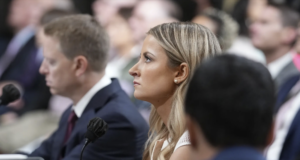In Jan. 6 Hearings, Gender Divide Has Been Strong Undercurrent
Before Sarah Matthews, a former deputy White House press secretary, even opened her mouth to testify on Thursday before the select committee investigating the Jan. 6 assault on the Capitol, the House Republican Conference attacked her on Twitter as a “liar” and a “pawn” of Democrats.
The group did not mention the man seated beside her, Matthew Pottinger, the former deputy national security adviser, who was also there to issue a scathing indictment of President Donald J. Trump’s behavior on the day of the riot. Nor did Mr. Trump himself mention Mr. Pottinger when he lashed out hours later with a statement calling Ms. Matthews a fame-seeker who was “clearly lying.”
The contrast highlighted how, in a series of revelatory hearings that have focused on issues of democracy, the rule of law and the peaceful transfer of power, another, less-discussed theme has emerged: the gender dynamics that have been a potent undercurrent.
In the course of exposing Mr. Trump’s elaborate effort to overturn the 2020 election, the House select committee has relied on the accounts of several women who came forward to publicly tell their stories. Their statements, and the attacks that ensued, laid bare how women often still pay a higher price than men for speaking up.
Representative Liz Cheney, Republican of Wyoming and the vice chairwoman of the panel — a woman who herself has suffered heavy consequences for her insistence on publicly condemning Mr. Trump’s conduct — has been explicit about the role of gender in the proceedings. She has positioned herself as the champion of the women who have agreed to testify in public, comparing them favorably with the many men who have refused to do so.
At the committee’s prime-time hearing on Thursday, Ms. Cheney wore a white jacket, the color of the women’s suffrage movement. She invoked Margaret Thatcher, the first woman to serve as prime minister of Britain, and the fight by American women to secure the right to vote as she described the women who had publicly appeared during the panel’s investigation as “an inspiration to American women and American girls.”
She was referring to Ms. Matthews as well as Cassidy Hutchinson, another White House aide who appeared at one of the committee’s hearings; Caroline Edwards, a Capitol Police officer who testified about how she was assaulted by the rioters, sustained a concussion and continued to fight them off; and Wandrea Moss and her mother, Ruby Freeman, election workers from Georgia who told the panel about how they endured harassment and death threats after Mr. Trump named them in a false conspiracy theory about voter fraud.
The result has been that as the committee unfurls the story of the Jan. 6 attack — playing footage of a mostly male crowd laying waste to the Capitol in Mr. Trump’s name, with the president looking on supportively from the West Wing — many of the witnesses who have emerged most prominently have been women, with Ms. Cheney as their defender.
It is a notable strategy by Ms. Cheney, a tough and hawkish conservative who throughout her career has worked to avoid being viewed through the lens of gender.
